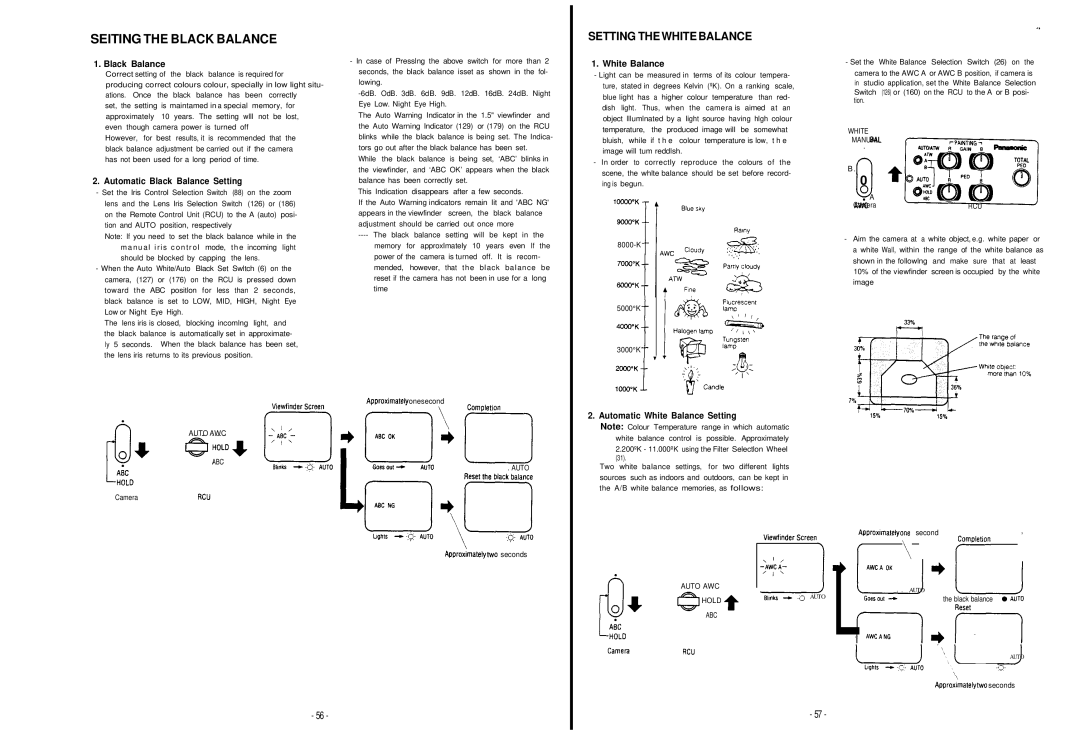
SElTING THE BLACK BALANCE
1. Black Balance
Correct setting of the black balance is required for
producing correct colours colour, specially in low light situ- ations. Once the black balance has been correctly
set, the setting is maintamed in a special memory, for approximately 10 years. The setting wlll not be lost, even though camera power is turned off
However, for best results, it is recommended that the black balance adjustment be carried out if the camera has not been used for a long period of time.
2. Automatic Black Balance Setting
-Set the Iris Control Selection Switch (88) on the zoom lens and the Lens Iris Selection Switch (126) or (186) on the Remote Control Unit (RCU) to the A (auto) posi- tion and AUTO position, respectively
Note: If you need to set the black balance while in the manua l iris control mode, the incoming light should be blocked by capping the lens.
-When the Auto White/Auto Black Set Swltch (6) on the camera, (127) or (176) on the RCU is pressed down toward the ABC positlon for less than 2 seconds, black balance is set to LOW, MID, HIGH, Night Eye Low or Night Eye High.
The lens iris is closed, blocking incomlng Iight, and the black balance is automatically set in approximate- ly 5 seconds. When the black balance has been set, the lens iris returns to its previous position.
-In case of Presslng the above switch for more than 2 seconds, the black balance isset as shown in the fol- lowing.
The Auto Warning Indicator in the 1.5" viewfinder and the Auto Warning Indicator (129) or (179) on the RCU blinks while the black balance is being set. The Indica- tors go out after the black balance has been set.
While the black balance is being set, ‘ABC’ blinks in the viewfinder, and ‘ABC OK’ appears when the black balance has been correctly set.
This Indication disappears after a few seconds.
If the Auto Warning indicators remain lit and 'ABC NG' appears in the viewfinder screen, the black balance adjustment should be carried out once more
----The black balance setting will be kept in the memory for approxlmately 10 years even If the power of the camera is turned off. It is recom- mended, however, that the black balance be reset if the camera has not been in use for a long time
onesecond
SETTING THE WHITE BALANCE
1. White Balance
- Light can be measured in terms of its colour tempera- ture, stated in degrees Kelvin (ºK). On a ranking scale, blue light has a higher colour temperature than red- dish light. Thus, when the camera is aimed at an object lllumlnated by a Iight source having hlgh colour temperature, the produced image will be somewhat bluish, while if t h e colour temperature is low, t h e image will tum reddlsh.
-In order to correctly reproduce the colours of the scene, the whlte balance should be set before record- ing is begun.
5000°K
3000°K
2. Automatic White Balance Setting
-Set the White Balance Selection Switch (26) on the
camera to the AWC A or AWC B position, if camera is in studio application, set the White Balance Selection Switch (126) or (160) on the RCU to the A or B posi- tion.
WHITE MANUAL
.
B .
0
A
CameraRCU
-Aim the camera at a white object, e.g. white paper or a white Wall, within the range of the white balance as shown in the followlng and make sure that at least 10% of the viewfinder screen is occupied by the white image
AUTO AWC
ABC
Camera
. AUTO
![]()
![]() seconds
seconds
Note: Colour Temperature range in which automatic white balance control is possible. Approximately
2.200ºK - 11.000ºK using the Filter Selectlon Wheel (31).
Two white balance settings, for two different Iights sources such as indoors and outdoors, can be kept in the A/B white balance memories, as follows:
AUTO AWC
HOLD
ABC
, ![]() second,
second,
AUTO | L | . AUTO |
| ||
| the black balance | |
|
| |
|
| AUTO |
|
| seconds |
- 56 -
- 57 -
